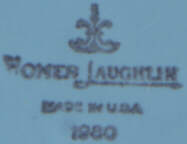 In May 1978, Homer Laughlin began working on a modeling program to reissue the Harlequin line at the request of F. W. Woolworth Company to celebrate their 100th anniversary.
In May 1978, Homer Laughlin began working on a modeling program to reissue the Harlequin line at the request of F. W. Woolworth Company to celebrate their 100th anniversary.
The limited line included the following:
- 10" dinner plate
- 7" salad plate
- soup/cereal bowl
- cup
- saucer
- vegetable bowl
- round platter (chop plate)
- covered sugar bowl
- creamer
The round platter, a.k.a. chop plate, was never part of the vintage Harlequin line. It was created for the reissue.
The covered sugar was modified with solid handles and finials. All other items were based on vintage models. The only piece considered which didn't make the cut was the 9" plate.
The colors consisted of: yellow, turquoise, coral, and green. The new green, often called, "reissue green", was a milky shade of the older medium green.
Most reissue Harlequin was sold in box sets of either a 20-piece service for four, or a 45-piece service for eight. There was also a five-piece "completer set" consisting of the covered sugar, creamer, vegetable bowl, and round platter.
Covered sugars were supposed to be made in yellow, creamers in turquoise, vegetable bowls in green, and round platters in coral. However, some vegetable bowls have been found in coral and yellow. Round platters have been found in yellow.
The line was sold until around 1983.
10" plates were usually given a general HLC backstamp with the year. Other pieces, such as the round platter and vegetable bowls, were sometimes marked with an HLC backstamp as well.
For the older Halrequin line produced from 1936 to 1964, see this page.
|